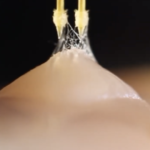News, Newly developed minimally-invasive 4D printed micro-needles
Researchers from Rutgers University, New Jersey, have created bio-inspired, programmable micro-needles that enhance tissue adhesion using Projection micro-stereolithography (PµSL). Influenced by the micro-hooks of parasites, barbed stingers of honeybees, and quills of porcupines, 4D printed backward-facing barbs were fabricated and designed to deform horizontally to be minimally invasive upon tissue contact. Howon Lee, the senior author of the study published in Advanced Functional Materials, explained: “We think our 4D printed micro-needle array will allow for more robust and sustained use of minimally invasive, pain-free and easy-to-use micro-needles for delivering drugs, healing wounds, bio-sensing, and other soft tissue applications.”
Learn about our two Decals!
 Click here to find out more about our Fall Bioinspired Design Decal and our Spring Bioinspired Design in Action Decal – ALL MAJORS are welcome.
Click here to find out more about our Fall Bioinspired Design Decal and our Spring Bioinspired Design in Action Decal – ALL MAJORS are welcome.Berkeley BioDesign Community
 Click here to learn about the BioD: Bio-Inspired Design @ Berkeley student organization or here to signup for more info.
Click here to learn about the BioD: Bio-Inspired Design @ Berkeley student organization or here to signup for more info.Search
Student Login





I imagine that the neurological circuits underlying these processes are governed by both 2d spacing maps with their brains as…
to reduce the impact of car accidents, it may be possible to study the force diverting physics of cockroaches to…
you see this type of head-bobbing stability in many avian creatures related to pigeons like chickens. the head ability to…
not like they taught horses how to run! this is an example of convergent evolution where both sea creatures and…
The brain functions in a similar way with neuronal connections. our brains are able to utilize the multiplicity of connections…